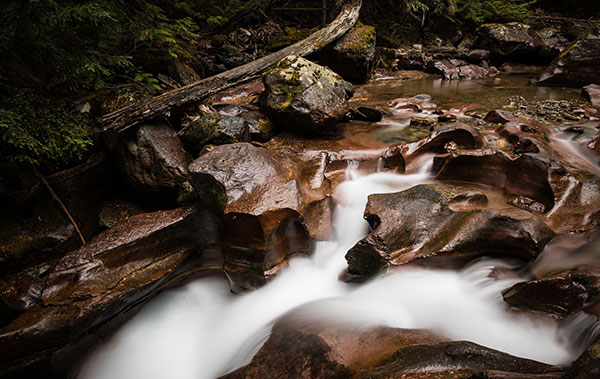Last updated: September 10, 2019
Lesson Plan
Erosion and Preservation of the Water Table

- Grade Level:
- Middle School: Sixth Grade through Eighth Grade
- Subject:
- Science
- Lesson Duration:
- 60 Minutes
Essential Question
How do different types of ground cover influence erosion?
Objective
Students will be able to:
• Investigate why ground cover is of primary importance in reducing the
rate of erosion in a natural environment.
• Create a model that shows the role of vegetation in retarding (slowing
down) erosion and preserving the water table.
• Research local flooding events.
Background
This lesson plan is part of Work House, a Glacier National Park Science and Indian Education Program. It can be done as a stand alone lesson and activity or as part of the larger Work House Program.
Be familiar with erosion and Glacier soils. Gather all the ground cover/soil materials needed. Identify a space to conduct the activity outside or inside (without creating a mess). Consider incorporating research and tie in annual flooding events, as well as the historic 1964 flood. (Starting on p. B59 of this USGS report is information and photo of the 1964 flood and Divide Creek at St. Mary, MT in Glacier National Park).
Preparation
- View the instructional video on how to set up the activity so that students can pour water on different ground covers.
- Two large trays
- A watering can with a sprinkling spout
- A fresh square of sod
- A bucket of sandy loam
Procedure
- Place the two trays so that one end is slightly higher than the other.
- Put the clump of sod on one tray and an equal pile of sandy loam on the other tray.
- Let the watering can rain for a period of time on each earth sample.
Possible Extensions
Science Extension: Can students make accurate predictions of what would happen with changes to the amount of ground cover? Changes in the terrain? Changes in the speed and amount of water added?
Field Trip Extension:
- Eco-enrichers- science lesson on plant and animal contributions to soil.
- Ranger-Led Field Trips and Service Learning Projects in Glacier National Park. Earth Science and Forest Processes field trips about park geology.
- Self-Guided Field Trips as well as Guided Tours - various concession operated - in Glacier National Park.
- Glacier Institute - geology and other education programs.
- Flathead CORE - outdoor education guide for field trips in the Flathead.
- Water/Stream Monitoring - MT Watercourse.
- Confederated Salish & Kootenai Tribal Natural Resources Dept., River Honoring- contact the Tribes for updates.
- Flathead Conservation District, Flathead Audubon, Whitefish Lake Institute- variety of related education/outreach projects.
Assessment Materials
Invite the students to discuss what happened and why. At the end of the activity have the group examine the two specimens for retained water content. How does vegetation retard erosion and preserve the water table?
Many tribes in Montana followed a yearly cycle of movement, directed by the seasons. How were annual flooding events less of an impact on livelihoods at that time than how we are living today? What do the trees and plants, forests and meadows of Glacier National Park and other vegetated areas do for the ecosystem? Discuss how human activities such as logging, fire management, agricultural activities and development in the surrounding ecosystem can help or hinder the goals (preservation and protection of natural and cultural resources) of Glacier National Park.
Additional Resources
- Explore the River, Interactive DVD - Confederated Salish & Kootenai Tribes, The DVD explores in detail the hydrology, habitat, fish, and Salish and Pend d’Oreille culture and history and their current efforts to restore the Jocko River.
- Flathead Community of Resource Educators Website - contains a resource link to the Flathead Watershed Sourcebook - information on cultural and natural history of the Flathead watershed and traveling trunks.
- Montana Watercourse - education trunks, water monitoring, and other water education programs and materials.
- Project Wet - water education activities and teacher workshops.
- Soil Science Society of America - educational materials kit.
